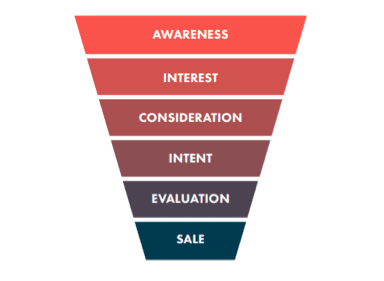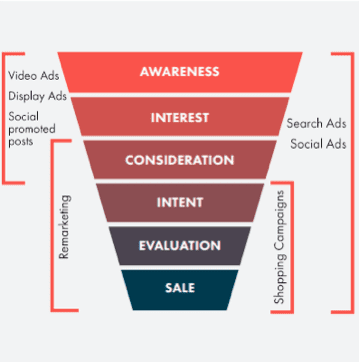Learn which types of PPC are most effective at the various stages of the sales funnel
Why does anybody do marketing? The fundamental answer is to make more money. You might argue that some campaigns have other motives, but ultimately all marketing activity funnels back to one end objective – sales (or a charitable equivalent).
However, in order to complete sales we need to break our approach down into a number of smaller goals and objectives. These form our different marketing approaches.
The potential customer who already knows exactly what they want or need should form the core of advertising efforts, but what about those who haven’t yet reached that stage?
Perhaps you’re in a niche industry or a competitive market – your potential customers may not have even heard of you. Even if they have, do they understand your unique selling points and what makes you different?
The clever marketer knows that, while they need to target the customers who are ready to buy or engage, they also need to encourage others to join that profitable group. The good old sales and marketing funnel helps us understand this and define the goals for our individual campaigns.
This diagram is usually front and centre in most marketing theory books, and for a very good reason. It should underpin every single marketing campaign you run as well as your overall strategy. Understanding what areas of the funnel you want to impact allows you to decide what type of channel you should use and how to measure success.
So, you’ve considered your goals and decided what part of the funnel you want to target, you now need to choose the appropriate online advertising channel. Let’s explore your options:
Pay per click (PPC) search advertising
This is all to do with the adverts you see at the top, bottom and to the right-hand side of search engine result pages. These text-based adverts show when a user enters a relevant search query that matches the keywords you have chosen for your campaign.
Words, by their very definition, show us meaning. In some cases they also highlight the intention of the writer. This allows us to show adverts when users type in transactional queries, including terms like “buy” or “book”, which suggest they are towards the bottom of the funnel. It also allows us to target simple and generic search terms, to show adverts to a wider range of users.
This makes PPC great for targeting every segment of the marketing funnel.
Banner adverts on Google’s display network and other providers
Image/banner ads can show on any website that has given advertisers permission. It’s an eye-catching way to demonstrate your brand to users researching content relevant to your business or product.
Unlike search advertising, banner ads are an ‘interruption’ form of marketing that sometimes doesn’t match the needs of the user at that point in time. Therefore it’s generally used for (but certainly not limited to) brand awareness campaigns.
Video advertising
Typically done via the world’s second biggest search engine, YouTube, video advertising is a fantastic way to generate brand awareness.
Video is the most engaging form of media and even if the user chooses to skip your ad, they’ve still been exposed to your brand (if you make the first five seconds sufficiently attention-grabbing). Repeat this at the start of multiple videos and you’ve got your brand message firmly lodged in the users’ minds.
Social advertising
Almost all the major social networks provide advertising options. Because users submit a lot of personal information on their profiles and when they interact with others, the targeting options can be extremely specific. Social advertising tends to come in two formats:
- Standard adverts that display in various positions within the interface. These types of ad are another form of ‘interruption’ advertising but, if targeted well, can be very relevant to the user. This makes standard ads potentially very effective across the entire funnel.
- Promoted content. These are standard posts that are pushed out to a wider (but targeted) audience, rather than those who already follow your brand page or profile. This is a great way to get content shared and get new followers to your page, making it very effective for brand awareness.
Remarketing
Ever visited a website and then been followed around the web with adverts from that company? That’s remarketing.
Remarketing is not only great for getting users back to your site who are ready to purchase, it’s also an excellent way to move them from higher up the funnel to that point.
It can be done with banner adverts on the Google display network, on social networks, YouTube and even using search adverts.
Shopping/product campaigns
If you have an e-commerce website, shopping campaigns can be the ultimate way to get highly qualified traffic to your product pages and through your checkout.
When users perform a relevant search in Google for an item that matches your product, a thumbnail image appears at the top of the search results page with the price.
The searches that trigger these ads to show are very specific and much more likely to convert if that user chooses to click. It’s for this reason that shopping campaigns are one of the best ways to target users at the bottom of the funnel and ready to buy. If they don’t click, maybe try some remarketing to bring them back!
Of course, all of these different campaign types can be used innovatively to affect the entire marketing funnel in different ways. The use and impact of each channel will also change across different industries and markets.
For example, promoted posts on Facebook can be an excellent way to highlight short-term offers for lifestyle and everyday retail products. They can therefore be extremely effective for direct response initiatives, not just brand awareness and loyalty.
Measuring Success
It goes without saying that you need to define your KPIs before embarking on any marketing campaign. This will, of course, vary significantly, depending on what part of the funnel you are targeting.
For example, if you are running a shopping campaign – one of your primary measures of success should be sales and revenue. However, it would be unfair to judge a brand awareness campaign via display advertising in the same way, as we know the target users are a long way off the point of conversion. In this instance we might look at other metrics such as traffic volumes and on-site behaviour to define success.
Unfortunately, many marketers will view campaigns as a failure if they do not generate direct leads or sales, even though the channel they are using is better suited to brand awareness. So it’s vital you not only choose the right channel for your marketing objective but that you review performance using the appropriate metrics.
Download our guide to Full-Funnel PPC Marketing
If you’d like to delve deeper into this topic, check out our Guide to Full-Funnel PPC Marketing.
from Smart Insights http://ift.tt/27S8c8h
via IFTTT



0 comments:
Post a Comment